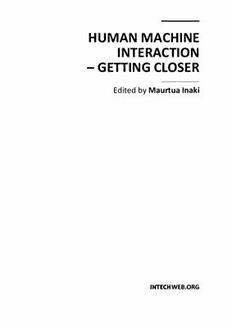
Human Machine Interaction - Getting Closer PDF
Preview Human Machine Interaction - Getting Closer
HUMAN MACHINE INTERACTION – GETTING CLOSER Edited by Maurtua Inaki Human Machine Interaction – Getting Closer Edited by Maurtua Inaki Published by InTech Janeza Trdine 9, 51000 Rijeka, Croatia Copyright © 2011 InTech All chapters are Open Access distributed under the Creative Commons Attribution 3.0 license, which allows users to download, copy and build upon published articles even for commercial purposes, as long as the author and publisher are properly credited, which ensures maximum dissemination and a wider impact of our publications. After this work has been published by InTech, authors have the right to republish it, in whole or part, in any publication of which they are the author, and to make other personal use of the work. Any republication, referencing or personal use of the work must explicitly identify the original source. As for readers, this license allows users to download, copy and build upon published chapters even for commercial purposes, as long as the author and publisher are properly credited, which ensures maximum dissemination and a wider impact of our publications. Notice Statements and opinions expressed in the chapters are these of the individual contributors and not necessarily those of the editors or publisher. No responsibility is accepted for the accuracy of information contained in the published chapters. The publisher assumes no responsibility for any damage or injury to persons or property arising out of the use of any materials, instructions, methods or ideas contained in the book. Publishing Process Manager Bojan Rafaj Technical Editor Teodora Smiljanic Cover Designer InTech Design Team First published January, 2012 Printed in Croatia A free online edition of this book is available at www.intechopen.com Additional hard copies can be obtained from [email protected] Human Machine Interaction – Getting Closer, Edited by Maurtua Inaki p. cm. ISBN 978-953-307-890-8 free online editions of InTech Books and Journals can be found at www.intechopen.com Contents Preface IX Part 1 HCI Development Process 1 Chapter 1 Automated Generation of User Interfaces - A Comparison of Models and Future Prospects 3 Helmut Horacek, Roman Popp and David Raneburger Chapter 2 Human-Machine Interaction and Agility in the Process of Developing Usable Software: A Client-User Oriented Synergy 17 Benigni Gladys and Gervasi Osvaldo Chapter 3 Affect Interpretation in Metaphorical and Simile Phenomena and Multithreading Dialogue Context 51 Li Zhang Chapter 4 Learning Physically Grounded Lexicons from Spoken Utterances 69 Ryo Taguchi, Naoto Iwahashi, Kotaro Funakoshi, Mikio Nakano, Takashi Nose and Tsuneo Nitta Chapter 5 New Frontiers for WebGIS Platforms Generation 85 Davide Di Pasquale, Giuseppe Fresta, Nicola Maiellaro, Marco Padula and Paolo Luigi Scala Chapter 6 Ergonomic Design of Human-CNC Machine Interface 115 Imtiaz Ali Khan Part 2 Human Robot Interaction 137 Chapter 7 Risk Assessment and Functional Safety Analysis to Design Safety Function of a Human-Cooperative Robot 155 Suwoong Lee and Yoji Yamada VI Contents Chapter 8 Improving Safety of Human-Robot Interaction Through Energy Regulation Control and Passive Compliant Design 155 Matteo Laffranchi, Nikos G. Tsagarakis and Darwin G. Caldwell Chapter 9 Monitoring Activities with Lower-Limb Exoskeletons 171 Juan C. Moreno and José L. Pons Chapter 10 Sensori-Motor Appropriation of an Artefact: A Neuroscientific Approach 187 Yves Rybarczyk, Philippe Hoppenot, Etienne Colle and Daniel R. Mestre Chapter 11 Cognitive Robotics in Industrial Environments 213 Stephan Puls, Jürgen Graf and Heinz Wörn Chapter 12 Intelligent Object Exploration 235 Robert Gaschler, Dov Katz, Martin Grund, Peter A. Frensch and Oliver Brock Preface The way in which humans and the devices that surround them interact is changing fast. The gaming business is pushing the trend towards more natural ways of interaction; the WII and KINNECT are good examples of this. Children are becoming familiar with these new interaction approaches, guaranteeing that we will use them in more “serious” applications in the future. Human-robot interaction is one of those applications that have attracted the attention of the research community. Here, the space sharing between robots and humans introduces an additional challenge, the risk management. In this book, the reader will find a set of papers divided into two sections. The first one presents different proposals focused on the development process itself. The second one is devoted to different aspects of the interaction, with special emphasis on the physical interaction. I would like to thank all of the authors for their contribution, my colleagues of the Smart and Autonomous System in TEKNIKER for their collaboration in the revision process and, of course, InTech for making the publication of this book possible. Maurtua Inaki, Autonomous and Smart Systems Unit, Fundación Tekniker Eibar, Gipuzkoa, Spain
